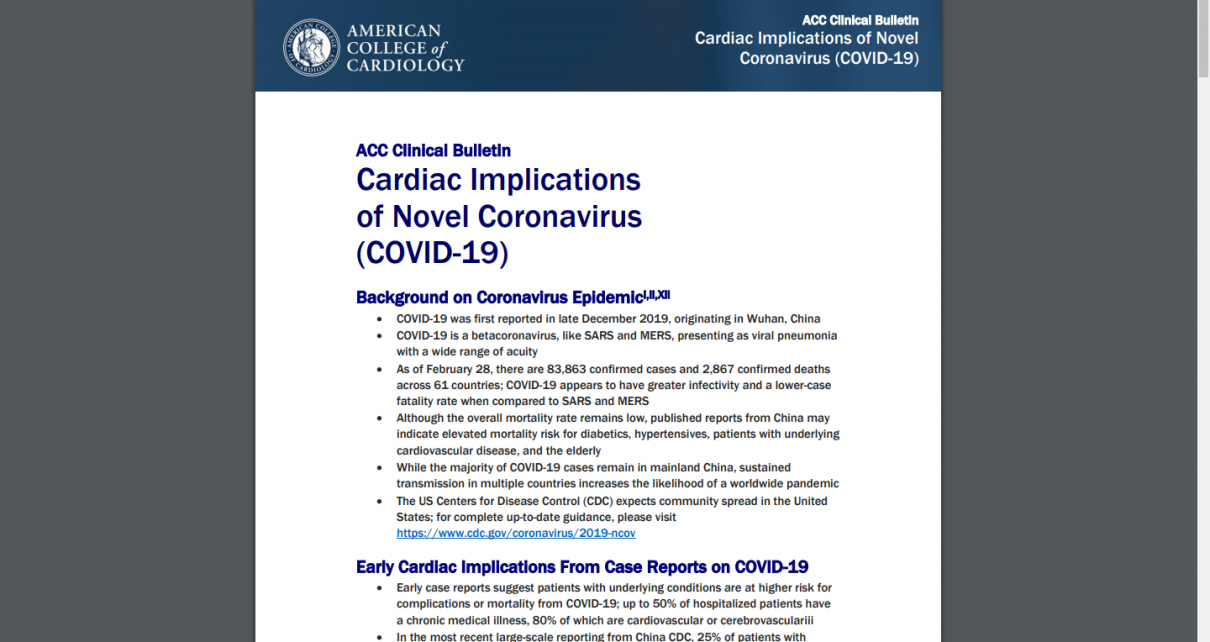The mortality rate can be deceiving… remember that the 2-3% thing is spread across the ENTIRE population. The mortality rate changes drastically for the MAJORITY. There are very few PERFECTLY healthy individuals.
From the Bulletin:
Early Cardiac Implications From Case Reports on COVID-19
• Early case reports suggest patients with underlying conditions are at higher risk for
complications or mortality from COVID-19; up to 50% of hospitalized patients have
a chronic medical illness, 80% of which are cardiovascular or cerebrovasculariii
• In the most recent large-scale reporting from China CDC, 25% of patients with
complete medical histories have comorbidities, the majority of which are
cardiovascular- or diabetes-related; while lower than initial reports, 53% of all
COVID-19 confirmed patients in the study were missing documentation of
underlying conditionsxii
• Overall the case mortality rate remains low at 2.3%; however, the mortality rate
jumps to 6% in hypertensives, 7.3% in diabetics, 10.5% in patients with
cardiovascular disease, and 14.8% for patients 80 years of agex
• Notably, the case mortality rate for underlying cardiovascular disease (10.5%) is
greater than in patients with underlying chronic respiratory disease (6.3%)
Report on 138 hospitalized COVID-19 patients:
o 19.6% of patients developed acute respiratory distress syndrome
o 16.7% of patients developed arrhythmia
o 7.2% developed acute cardiac injury
o 8.7% of patients developed shock
o 3.6% developed acute kidney injury
o Rates of complication were universally higher for ICU patients
• The first reported death was a 61-year-old male, with a long history of smoking, who
succumbed to acute respiratory distress, heart failure, and cardiac arrest
• Early, unpublished first-hand reports suggest at least some patients develop
myocarditis
Potential Cardiac Implications From ana|og Viral Respiratory
Pandemics
• Influenza ana|og: In all influenza pandemics other than the 1918 flu, cardiovascular
events surpassed all other causes of mortality, including superimposed pneumoniav
• General viral ana|og: Viral illness is a well-known destabilizing factor in chronic
cardiovascular disease, a general consequence of the imbalance between infectioninduced increased metabolic demand and reduced cardiac reserve. The viral
infection along with superimposed pneumonia will directly and indirectly affect the
cardiovascular systemvi
o Both coronary artery disease and heart failure patients are at increased risk
of acute events or exacerbation; viral illness can potentially destabilize
coronary plaques through several mechanisms including systemic
inflammatory responses which have been recently documented with COVID19
o Multiple co-morbidities (DM, obesity, HTN, COPD, CKD) further increase risk
• SARS/MERS ana|og: Although published literature on CV implications of
SARS/MERS is limited, in the absence of more detailed reporting on COVID-19, it
may prove instructive
o 60% of MERS cases had one or more pre-existing comorbidity, resulting in a
poorer prognosis; expert guidance suggests patients with diabetes, CVD, or
renal disease should be prioritized for treatmentvii
o Both SARS and MERS have been linked to acute myocarditis, acute
myocardial infarction, and rapid-onset heart failure
▪ In one early published report, 2 out of the 5 deaths were attributed
to MIviii,ix
▪ These data should be interpreted cautiously—indicative of the
increased CV risk in coronavirus patients, but not generalizable to
broader outcomes
ACC Clinical Bulletin
Cardiac Implications of Novel
Coronavirus (COVID-19)
o Reversible, sub-clinical diastolic LV impairment in acute SARS even among
those without underlying cardiac disease appears common, likely the result
of systemic inflammatory immune response and is not unique to SARS;
however, lower EF upon admission was predictive of later mechanical
ventilation x
o In one study of cardiovascular complications of SARS in 121 patients:xi
– 71.9% of patients developed persistent tachycardia, including 40%
with continued tachycardia during outpatient follow-up
-50.4% of patients developed sustained asymptomatic hypotension
during hospitalization; one patient required inotropic support
– 14.9% of patients developed transient bradycardia
– 10.7% of patients developed transient cardiomegaly, without signs
or symptoms of heart failure
– One patient experienced transient paroxysmal AF, with spontaneous
resolution
_- Cardiovascular complications appeared statistically uncorrelated
with oxygen desaturation or ICU admission
Full bulletin at link: https://www.acc.org/~/media/665AFA1E710B4B3293138D14BE8D1213.pdf




